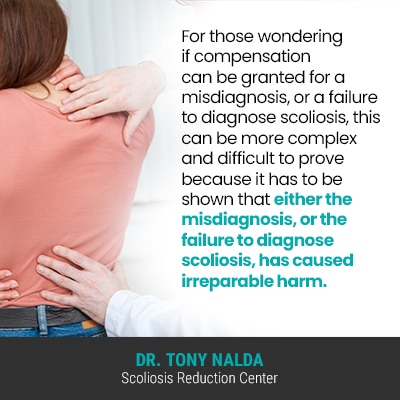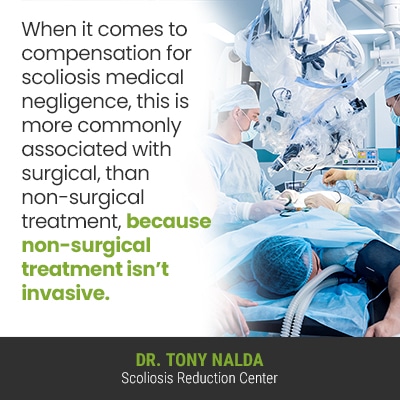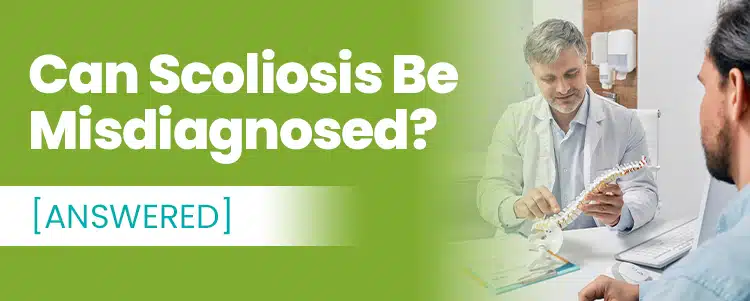With current estimates at close to 7 million people currently living with scoliosis in the United States alone, it is a highly-prevalent spinal condition; scoliosis is also the leading spinal condition amongst school-aged children. As a complex spinal condition affecting so many, scoliosis awareness is important because it can lead to early detection and potential treatment success.
There are a number of spinal conditions a person can develop that cause a loss of its healthy curves, but scoliosis has a number of condition characteristics that set it apart from the rest, making it difficult to misdiagnose.
Let’s start our exploration of whether or not scoliosis is a condition that’s easy to misdiagnose by first defining the condition itself, and how it’s diagnosed.
What is Scoliosis?
Scoliosis is the development of an unnatural sideways spinal curve, and as a progressive condition, scoliosis has it in its nature to get worse over time.
Scoliosis introduces a lot of uneven forces to the spine, its surrounding muscles and nerves, and the body in general.
Scoliosis progressing means the size of the unnatural spinal curve is increasing over time, and as this happens, the spine becomes increasingly rigid and less responsive to treatment; in addition, spinal rigidity can make it difficult for some patients to perform key therapeutic exercises as part of treatment.
Scoliosis also ranges widely in severity, and there are also different types of scoliosis a person can develop.
The majority of scoliosis cases are classified as idiopathic, meaning not clearly associated with a single-known cause, and this type accounts for approximately 80 percent of known diagnosed cases, and the remaining 20 percent are associated with known causes: neuromuscular scoliosis, degenerative scoliosis, and congenital scoliosis.
Neuromuscular scoliosis is caused by the presence of a larger neuromuscular condition, and degenerative scoliosis is caused by natural age-related spinal degeneration, while congenital scoliosis is a rare type that babies are born with due to a malformed spine that developed in utero.
So part of the diagnostic process involves comprehensive assessment to further classify conditions based on key variables: patient age, condition type, severity, and curvature location; as you can see, there are a lot of different patient/condition characteristics that lead to a diagnosis of scoliosis.
Let’s now address the parameters that have to be met to reach a diagnosis of scoliosis.
Diagnosing Scoliosis

As mentioned earlier, there are a number of spinal conditions that involve the development of an unnatural spinal curve, including kyphosis and lordosis, but scoliosis has some unique characteristics that make it hard to misdiagnose, as well as complex to treat.
So an unnatural lateral (side-to-side) curvature of the spine doesn’t guarantee a diagnosis of scoliosis because scoliosis is a 3-dimensional condition, meaning the spine doesn’t just bend unnaturally to the side, but also twists from front to back, back to front, and this is not the case with most other typical spinal conditions that cause a loss of its healthy curves.
In addition, the size of the unnatural spinal curve has to be specific to be diagnosed as a scoliotic curve, and that means a Cobb angle measurement of at least 10 degrees.
A patient’s Cobb angle is determined during X-ray by drawing lines from the tops and bottoms of the curve’s most-tilted vertebrae, and the resulting angle is expressed in degrees and classifies conditions in terms of severity:
- Mild scoliosis: Cobb angle measurement of between 10 and 25 degrees
- Moderate scoliosis: Cobb angle measurement of between 25 and 40 degrees
- Severe scoliosis: Cobb angle measurement of 40+ degrees
- Very-severe scoliosis: Cobb angle measurement of 80+ degrees
So as you can see, scoliosis ranges widely in severity, and the higher a patient’s Cobb angle, the more severe the condition, and the more noticeable its effects are likely to be.
The main effect of scoliosis in children is postural deviation, and the main effect of scoliosis in adults is pain, and this is because scoliosis doesn’t become a compressive condition until skeletal maturity has been reached; growing spines are experiencing a constant lengthening motion, and that counteracts the compressive force of the scoliotic curve.
It’s compression of the spine and its surrounding muscles and nerves that causes the majority of condition-related pain, and the lengthening motion of a growing spine can counteract those compressive forces, making it less painful for children.
So can scoliosis be misdiagnosed: not easily, and certainly not by a medical professional who’s aware of the condition’s specific diagnostic parameters and cutting-off points.
As an X-ray needs to be performed to truly see what’s happening in and around the spine, to confirm a rotational component, and a patient’s Cobb angle measurement, it’s even harder to misdiagnose scoliosis.
If a person is diagnosed with mild scoliosis, they are at an advantage because the condition was diagnosed early in its progressive line.
The Benefit of Early Detection

While I can never give treatment guarantees, when detected early in a codnition’s progressive line, when it’s the simplest to treat, and if a diagnosis is met with proactive treatment, there are fewer limits to what can be achieved.
When it comes to progressive conditions like scoliosis, when treatment is started can be almost as important as the type of treatment started; the best time to start scoliosis treatment is always now.
So if a diagnosis of scoliosis is reached, there are two main scoliosis treatment approaches to choose between: traditional (surgical) and conservative (non-surgical).
When it comes to compensation for scoliosis medical negligence, this is more commonly associated with surgical, than non-surgical treatment, because non-surgical treatment is non-invasive.
Scoliosis surgery, known as spinal fusion, is an invasive and costly procedure that involves fusing the most-tilted vertebrae of the curve into one solid bone and attaching rods to the spine with pedicle screws to hold it in place; this, however, is contrary to the spine’s natural movement-based design.
So some patients experience complications related to living with a fused spine such as hardware malfunction, and while rare, a screw coming loose and causing damage can happen, and when that happens, or an unexpected complication develops due to a surgeon’s negligence, compensation can be granted when deemed legally appropriate and/or when there is an admission of liability.
For those wondering if compensation can be granted for a misdiagnosis, or a failure to diagnose scoliosis, this can be more complex and difficult to prove because it has to be shown that either the misdiagnosis, or the failure to diagnose scoliosis, has caused irreparable harm.
There is no clear-cut answer as to what types of compensation can be expected; too many variables are involved, and only professional legal counsel can accurately estimate how much potential compensation for scoliosis medical negligence can be awarded.
Conclusion
The spine is a complex structure with many moving parts, and in addition to providing the human body with structure, protecting organs, allowing us to remain upright and practice healthy posture, the spinal cord within also partners with the brain to form the body’s central nervous system.
There are a number of spinal conditions/issues a person can develop, many of which involve the spine losing one or more of its healthy curves, but scoliosis is a particularly complex spinal condition that’s difficult to misdiagnose because it requires an X-ray, and a series of complex measurements, to do so.
In order to reach a diagnosis of scoliosis, an unnatural sideways spinal curve that also rotates has to be present, and it’s the 3-dimensional nature of scoliosis that sets it apart from other common spinal conditions such as kyphosis and lordosis.
In addition, scoliosis is progressive in nature, meaning it’s virtually guaranteed to get worse over time, and this is why being proactive with treatment is so important.
Misdiagnosing scoliosis is difficult because an X-ray is necessary to confirm the rotational component and to measure the patient’s Cobb angle; a minimum Cobb angle measurement of 10 degrees is needed to be considered a true scoliosis.
It’s hard to misread an X-ray, especially for a medical professional who specializes in scoliosis; in fact, scoliosis X-rays involve taking a number of complex measurements, which is why it’s always recommended to seek the help of a scoliosis specialist.
Here at the Scoliosis Reduction Center®, I start treatment as close to the time of diagnosis as possible because this is when the condition is going to be at its mildest and most responsive; remember, scoliosis isn’t a static condition, so where it is at the time of diagnosis isn’t indicative of where it wills stay.




